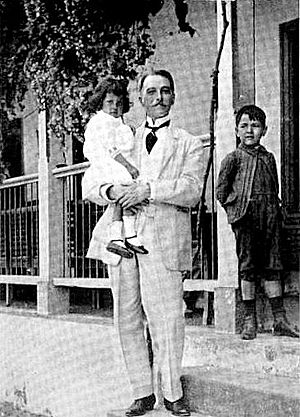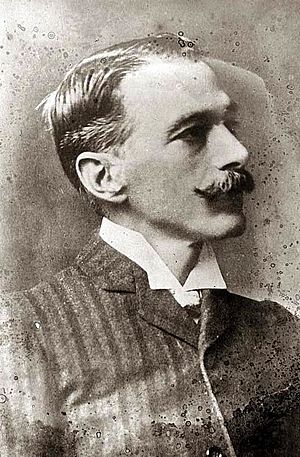Carlos Eugenio Restrepo facts for kids
Quick facts for kids
Carlos Eugenio Restrepo
|
|
|---|---|
 |
|
| 7th President of Colombia | |
| In office August 7, 1910 – August 7, 1914 |
|
| Preceded by | Ramón González Valencia |
| Succeeded by | José Vicente Concha |
| Minister of Government | |
| In office August 7, 1930 – July 28, 1931 |
|
| Preceded by | Alejandro Cabal Pombo |
| Succeeded by | Agustin Morales Olaya |
| Personal details | |
| Born |
Carlos Eugenio Restrepo Restrepo
September 12, 1867 Medellín, Antioquia, United States of Colombia |
| Died | July 6, 1937 (aged 69) Medellín, Antioquia, Colombia |
| Political party | Conservative |
| Spouse | Isabel Gaviria Duque |
| Children | 9 |
| Alma mater | Seminario Conciliar de Medellín |
| Occupation | Author, Journalist, Educator (Professor) |
| Profession | Lawyer |
| Nickname | Monsieur Veto |
Carlos Eugenio Restrepo Restrepo (born September 12, 1867 – died July 6, 1937) was a Colombian lawyer, writer, and important leader. He was elected President of Colombia in 1910. During his time as president, he worked hard to bring together the two main political groups, the Conservative and Liberal parties. He even included members of the Liberal Party in his team. He also tried to stay neutral on many issues. Later, he became the Minister of Government and an Ambassador to the Vatican City State.
Contents
Early Life and Education

Carlos Restrepo's Family
Carlos Restrepo was born in Medellín, Colombia. His parents were Cruzana Restrepo Jaramillo and Pedro Antonio Restrepo. His father was a lawyer and helped start the town of Andes.
Carlos married Isabel Gaviria Duque on April 16, 1890. They had nine children together.
His Education Journey
Carlos Restrepo went to school in Itagüí and Medellín. He later studied Law. However, he had to stop his studies when he was 18 because of a Civil War in 1885. He taught himself law while working at his father's law firm.
Professional and Public Service
Becoming a Lawyer and Educator
Carlos Restrepo quickly became a respected lawyer. He worked as an inspector for education in 1888. He then became a prosecutor and a judge. Later, he became the top lawyer for the Antioquia region in 1898.
He also taught law at the University of Antioquia and became the university's head (Rector). He cared about helping others. He helped start the Colombian Red Cross in Medellín. He also led the Society of Saint Vincent de Paul in Colombia. In 1901, he founded a group to improve public works in Medellín.
Military Service in the Civil War
When the Thousand Days' War (1899–1902) broke out, Carlos Restrepo joined the Conservative party. He volunteered to fight in this civil war. He served as the Chief of Staff for the army under General Pedro Nel Ospina.
Political Career and Presidency
Starting a New Political Movement
Carlos Restrepo was a member of the Colombian Conservative Party. In 1909, he helped create a new political group called the Unión Republicana (Republican Union). This party wanted to bring political groups together. It also focused on modern ideas and building a strong National identity.
This new movement had support from important members of both the Conservative and Liberal parties. Some of these leaders included José Vicente Concha and Enrique Olaya Herrera.
Becoming President of Colombia
In 1910, the National Assembly met to choose a new president. Carlos Restrepo was one of the candidates. On July 15, 1910, he won the election. He received 23 votes, while his opponent, José Vicente Concha, received 18 votes.
Carlos Restrepo became president on August 7, 1910. He was the first person from Antioquia to become president. His victory was a surprise to many. He won support from both major political parties.
He became the 12th President of Colombia, serving from 1910 to 1914.
Presidential Term (1910–1914)
Changes at Home (Domestic Policy)
During his presidency, Carlos Restrepo was known as Monsieur Veto. This nickname came from his habit of saying "no" (vetoing) to any proposed law he felt was not good for the country.
Some important things that happened during his time as president include:
- Ending the capital punishment (death penalty).
- Making sure Congress met every year.
- Giving lifetime payments (pensions) to retired teachers.
- Building hospitals in the Caribbean area to fight tropical diseases.
When Restrepo became president, Colombia had big money problems. The government was spending much more than it was earning. He worked to collect taxes better and cut government spending. In less than a year, he fixed the problem. By 1911, the country had extra money. Colombia's economy also got better because taxes were raised and the price of Colombian coffee went up.
He also stopped the government from printing new banknotes. He brought back the use of gold and silver as the basis for money.
He improved the Colombian National Police. He introduced Fingerprinting and created the first police training academy. He also helped set up financial support for families of police officers who died.
New Regions for Colombia
To help Colombia control its borders, new areas were created. These included the Intendencia of San Andres y Providencia and the Comisarías of Caquetá and Vichada. These new areas helped Colombia claim its land from neighboring countries. Later, these areas became official Departments.
Relations with Other Countries (Foreign Policy)
During Restrepo's presidency, Colombia faced threats from Peru and still felt upset with the United States because of its role in Panama's separation. Restrepo knew Colombia's military was not strong enough for war. So, he tried to solve problems using diplomacy (talking and agreements).
Colombia and Peru
The jungles in the south of Colombia, near the Putumayo and Caquetá, became a problem with Peru. The borders were not clear. A Peruvian company, Casa Arana, was using resources in Colombian territory and treating local Indigenous people badly. News reports of killings by this company made the situation worse. In July 1911, Peruvian forces attacked a Colombian military base.
Many people and Congress wanted to go to war. But Colombia had just finished the Thousand Days' War and did not want another conflict. President Restrepo did not want war. He wanted to solve things peacefully. His Minister of Foreign Affairs, Enrique Olaya Herrera, worked on this. On July 15, 1911, Colombia and Peru signed an agreement to stop fighting.
The conflict also ended because many Peruvian soldiers in the area got sick with diseases like beriberi and yellow fever. This conflict would come up again in 1934.
Colombia, United States, and Panama
Colombia was still upset with the United States for its part in the Separation of Panama from Colombia. Carlos Restrepo also thought the United States was wrong to get involved in the Mexican Revolution.
However, on April 6, 1914, Colombia and the United States signed the Thomson–Urrutia Treaty. In this treaty, Colombia accepted Panama's independence. Colombia also got free access to the Panama Canal. The United States officially apologized for its role in Panama's separation and agreed to pay Colombia $25 million. This was a big success for Colombia. It helped fix problems with Panama and improve relations with the United States.
After the Presidency
Carlos Restrepo's time as president ended on August 7, 1914. He was replaced by José Vicente Concha. After leaving office, Restrepo moved back to Medellín. He went back to his writing and business activities.
In 1920, Carlos Restrepo helped create a shipping company called "La Naviera Colombiana" (The Colombian Shipping Company). This company used steamships to carry goods and people on the Magdalena River. This was a big step forward for transportation in Colombia. The company even had luxury riverboats with dining rooms and first-class service.
He returned to politics in 1930. He supported his friend Enrique Olaya Herrera for president. When Olaya Herrera became president on August 7, 1930, he chose Carlos Restrepo to be his Minister of Government.
Later, Carlos Restrepo was appointed as an Ambassador to the Vatican City State.
Death and Lasting Impact
Carlos Eugenio Restrepo passed away on July 6, 1937, in his home city of Medellín. He was 69 years old and died after getting pneumonia.
Carlos E. Restrepo and General Pedro Nel Ospina were seen as smart leaders who wanted to bring peace and balance between political groups. His efforts to achieve peace are considered one of his most important legacies.
During his time, he was known as a modern and forward-thinking leader in South America. He was a skilled lawyer and a well-known writer.
See also
 In Spanish: Carlos Eugenio Restrepo para niños
In Spanish: Carlos Eugenio Restrepo para niños
Images for kids
-
Restrepo's Minister of Foreign Relations and future president, Enrique Olaya Herrera.



